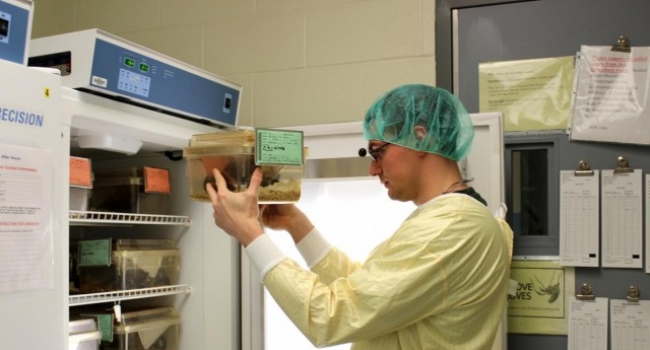- Latest news▼
-
18:00, April 18 Daily Mail: Elderly woman in China gets infected with brain-eating amoeba

-
14:19, April 18 Obesity: exercising before breakfast helps you lose weight faster

-
10:42, April 18 The Conversation: childhood trauma can cause pathological hoarding

-
08:37, April 18 Daily Mail: Satiating food reduces cravings for sweets, nutritionist says

-
18:22, April 17 First Armenian-German Conference entitled “Heart Failure Spring School”

-
08:38, April 17 Why do kids usually recover from COVID-19 more easily than adults?

-
14:37, April 16 Daily Mail: intermittent fasting is not suitable for children and women before their periods

-
16:41, April 15 Cell: in carriers of defective BRCA2 gene, sugar consumption increases cancer risk

-
15:04, April 15 305 cases of measles recorded in Armenia so far in 2024

-
14:38, April 15 Food and Environmental Virology: tea contributes to effective coronavirus control

-
12:41, April 15 Daily Mail: vitamin A, B3 and E supplements can be dangerous

-
10:56, April 15 Diabetes Care: evening physical activity is good for the heart

-
08:27, April 15 Women are more susceptible to blood loss and death during bypass surgery than men, researchers say

-
18:42, April 13 WHO: Nigeria pioneers revolutionary meningitis vaccine

-
16:43, April 13 One-third of women experience menstruation-related migraines, most often during premenopause - study

All materials
Are cold lab mice undermining science?

Mice like it warm, scientists from the Roswell Park Cancer Institute point out. Yet most labs keep them at a temperature more comfortable for human researchers. The difference can affect the way rodents respond to diseases and medication, and make them less reliable models for human conditions. Changing the lab temperature could mean big things for medical research.
"Most people only look at results from experiments at standard lab temperatures," said Dr. Bonnie Hylander in a statement. "They're not necessarily aware that if you repeat the experiments with mice at a different temperature, you might get a different outcome."
Most labs keep mice between 20 and 26°C (68 and 79°F), in line with National Research Council guidelines. From a human perspective, this makes sense. Researchers and technicians wear coats and gloves in the lab, and become uncomfortable at higher temperatures. However, mice lose so much heat through their large surface area, relative to volume, that they prefer 30 to 32°C (86 to 89°F), spending more time in warm locations if offered the chance.
In Trends in Cancer, Hylander points out that the need to make up the extra heat changes the mouse metabolism, which in turn causes them to eat more food and store less energy for later activity. “The 'mild' cold stress caused by standard sub-thermoneutral housing temperatures used for laboratory mice in research institutes is sufficient to significantly bias conclusions drawn from murine models of several human diseases,” the paper argues.
In 2013, Hylander co-authored a paper showing that mice have a better chance of fighting off cancer when they are kept at their preferred temperature, with tumors growing more slowly and being less likely to metastasize.
Since then she has been exploring whether this temperature difference changes treatment effectiveness. "While animal physiologists have recognized the potential of this problem for some time, we were surprised that essentially no work was done on cancer models,” said Dr. Elizabeth Repasky, who is collaborating with Hylander, in a statement. “We thought it was very important to highlight how many other areas of biomedical research, some related to cancer, are influenced by standard housing temperatures."
So what is the solution? Can mice and researchers find a mutually satisfactory temperature? Or do we need to keep our mice wearing adorable little sweaters?
"We're not saying one housing temperature is better than another," Repasky argued. "The different temperatures are simply resulting in differences in experimental outcomes, which could be important. I think a lot more research is needed to optimize the use of mice for testing therapies that will be useful in people."
What Repasky and Hylander do suggest is that researchers monitor the temperatures at which mice are kept, and report this in papers. Additional nesting material could also help keep mice warm. They also note care should be taken to ensure common conditions for mice in a study - if test mice are kept higher, where it is warmer, than the controls, differences in temperature might be more influential than the medication being tested.
Follow NEWS.am Medicine on Facebook and Twitter
- Video
- Event calendar
- Archive
- Most read
month
week
day
- Pediatrics: Hypoglossal nerve stimulation implant helps with sleep apnea 1362
- WHO: Nigeria pioneers revolutionary meningitis vaccine 1169
- One-third of women experience menstruation-related migraines, most often during premenopause - study 1136
- Women are more susceptible to blood loss and death during bypass surgery than men, researchers say 952
- Food and Environmental Virology: tea contributes to effective coronavirus control 930
- Daily Mail: vitamin A, B3 and E supplements can be dangerous 929
- Cell: in carriers of defective BRCA2 gene, sugar consumption increases cancer risk 901
- 305 cases of measles recorded in Armenia so far in 2024 893
- Diabetes Care: evening physical activity is good for the heart 883
- Daily Mail: intermittent fasting is not suitable for children and women before their periods 706
- First Armenian-German Conference entitled “Heart Failure Spring School” 499
- Why do kids usually recover from COVID-19 more easily than adults? 371
- Obesity: exercising before breakfast helps you lose weight faster 356
- The Conversation: childhood trauma can cause pathological hoarding 350
- Daily Mail: Satiating food reduces cravings for sweets, nutritionist says 324
- Find us on Facebook
- Poll





